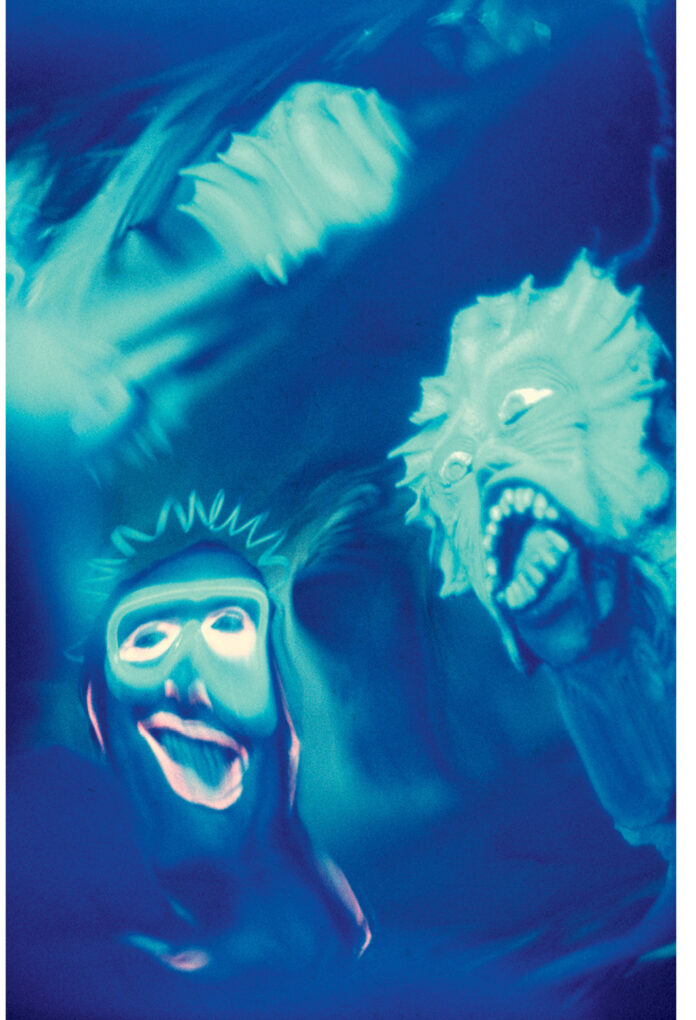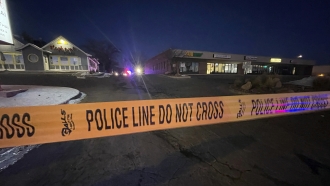
A REDDIT USER POSTS, “My mom told me to unalive myself because I am gay.” The thread responds (and I paraphrase, slightly): “Your egg donor sucks and doesn’t deserve the term ‘mom.’” To unalive yourself is to allow the forces of oppression to remove you from life. Algospeak neologisms are coined to avoid AI censorship; sublimation produces a new sign. The death drive merges with the life instinct to create a new condition: unaliving. Not the opposite of “liveness,” as in the TV era’s distinction between the prerecorded and the happening-now—we are way past that after two years of nonstop Zoom meetings and streaming performance art from empty theaters—but the sense that life and death, between and after, are more and more the same.
Experiencing middle age in a scary, then tedious, pandemic, I picked up unalive from millennial and Zoomer informants who transport messages from other generational realms. My techno-DJ buddy told me about a gamer streaming on Twitch who used “unalive” instead of “kill” while blowing away digital soldiers. Another pal, a Dungeons & Dragons podcaster, unemployed and uninsured, put me on a list of people to call as he struggled with suicidal ideation. We used “commit unalive” to distance ourselves from the grimness of his situation.
TikTok has already blocked the hashtag #unalive, but variants proliferate:
#unalivetome 32.7k views
#unalivebodies 9,228 views
#unalivethoughts 55k views
#unaliveawareness 2.3m views
I don’t click through but instead project my own interpretations. #unalivetome is a summoning spell for #unalivebodies; #unalivebodies are animated biota circulating across screens; #unalivethoughts describes the flat imagination behind the unblinking eyes of #unalivebodies; #unaliveawareness is what I am attempting to conjure, a zeitgeist springing like shrapnel from the cultural detonation of the Anthropocene, an unhuman consciousness born from imminent planetary annihilation.
“Unaliving” is a flavorless smoothie blending elements of Foucauldian biopower with Achille Mbembe’s necropolitics; its economic base is technofeudalism. Our latest capitalist dystopia is devoid of innovation but awash in the licensing of intellectual property and goods we can rent but never own. What passes for sovereignty is the ability to disappear. Rolling quarantine, individuated and self-initiated, is a privilege enjoyed by those of us who can afford to excuse ourselves from public space, if not the workplace, which follows us wherever Wi-Fi and 5G are available, making the domestic setting of the unalive a mash-up of The Office and The Decameron. Biopolitics separates audiences by generational immune responses: Vaccination was required to see Patti LuPone on Broadway but not Doja Cat at Coachella. Labor is replaced by the bookmarking of URLs, the updating of apps, and the verifying of one’s sentience, typically by interpreting blurry images of infrastructure from an increasingly remote outside world. Biopower, its racial categorization and class distinctions reified through branding, has become the ghost in the shell. That spark once referred to as spirit becomes a server holding passwords, a Ouija planchette navigating interfaces linking bank accounts.
Unaliving is the internalization of the failure of the promise of biopower—that life is under political control—and the threat of necropower: that death will be meted out by political terror. Hovering between forces of despair, the unalive have only to pay their ballooning rent. Jack Smith clocked it half a century ago as landlordism, paying to play on Rented Island. Smith was mad that he had to pay rent more than once; what would he think of Airbnb? Consuming, such as it is, is now a process of managing subscriptions. On the Marvel Unlimited app, I scroll through comics I owned for real as a kid, now untouchable beneath my smooth glass tablet. I think of Smith’s ’60s photographic performance collaborations with Ira Cohen. Shot reflected in distorting Mylar, Smith performed as “Electromagneto,” amalgamating comic-book villains from The Amazing Spider-Man and The Uncanny X-Men into an alter ego, dramatizing an escape not only from the confines of the human body but from the servitude of copyright.

JACK SMITH died of AIDS in 1989, when I was sixteen. I came of age amid the apex of the virus. Years later, in 2012, Truvada afforded a stretch of unfettered sexual exploration before Covid-19 shut me down. Now a new (currently) gay-themed plague, monkeypox, marks us as vectors. To get a monkeypox vaccine in New York City—available only to those most at risk—one must continually refresh an NYC.gov web page. When the limited supply becomes available, the link opens to a page that unceremoniously reads, “Service Unavailable.” Unaliving the day away, I refresh the broken interface of a system where inaccessibility to existing immunization is a feature, not a bug.
Frozen in front of a screen, alienated from other bodies by a palpable force field of low-grade hysteria, I am exactly where they want me. Removed from the lifeworld yet not a direct target of the deathworld, I prioritize my #unalivebody over the one that is aging. I used to like sex with strangers at queer parties and clubs, but now the thought of touching those soaking skins is fantastical, if not repugnant. Caught in the middle, I can feel the warmth not of the promised queer future but of the still-smoldering gay past. Dead stars shine so bright we can see them through telescopes even millions of years after burnout.
Unaliving is the internalization of the failure of the promise of biopower—that life is under political control—and the threat of necropower: that death will be meted out by political terror.
The late José Esteban Muñoz wrote that “we are not yet queer. We may never touch queerness, but we can feel it as the warm illumination of a horizon imbued with potentiality.”1 What if the “not yet” can also come before the now? People sometimes imagine that utopia is timeless, universal, but utopias always have borders, whether spatial or temporal. Utopia and separatism are coconstitutive, enabling minority populations to build worlds together, but only for a time. In Jayna Brown’s Black Utopias: Speculative Life and the Music of Other Worlds (2021), the author traces successful utopian projects by Black women, including the Shaker visionary Rebecca Cox Jackson and Octavia Butler’s fictional prophet Lauren Olamina,2 founder of the speculative religion Earthseed, which teaches that we must leave our planet to make space for Black women, among others, to thrive.
A moment in Brown’s book I can’t stop thinking about: In looking at the biocentrism of Butler’s fiction, she discusses how Sylvia Wynter traces the “borders of where humanity is,”3 the ultimate separation made by, as Wynter puts it, “we ourselves, not extrahuman entities.” Brown seizes on this phrase:
But why not extrahuman entities? . . . I am tickled by the idea of extrahuman entities residing among us. These entities are not responsible for the ways the genre of the human is currently understood and practiced. Rather, in my imagination these entities are suggesting, perhaps in a register we are not attuned to, that other forms of being are possible if we begin to reach for, or practice, forms of interchange, relationality, and communality based in immersion in the nonhuman world.4
Brown connects this critique to a recent turn in queer theory toward “inhumanism,” a move—evident in writing by Mel Y. Chen, Tavia Nyong’o, and Zakiyyah Iman Jackson—expanding queerness to nonhuman materialities, challenging Western epistemes, and critically engaging anti-Blackness and Indigenous erasure of scientific hierarchies. This questioning of foundational differentiation, of self as opposed to other, is meant not to collapse but to specify. Can we have life, nonlife, unlife? When I read about these extrahumans, I imagine their tickling presence summoned into the present through art, media, mediation, the medium. Brown cautions that we are “not attuned to” their registers, but in my unalive state, I feel them everywhere.

I GREW UP ON COMICS and have become a scholar of imaginary mutant creatures. Superheroes are the unalive par excellence: Commercially licensed by corporations, appropriated by fans, the characters disappear between panels, go into the reader’s mind and burrow in, and there they battle, endlessly, in a recurring mythic allegory of biopower and necropolitics. Rampant, exhausting but seemingly inexhaustible, superheroes never were and yet they’re everywhere. An attempt to find form for the extrahuman entities exceeds what passes for life, what we think of as death. They die a lot, and come back even more.
I think about an issue from 1984, Uncanny X-Men no. 186, “Lifedeath: A Love Story.”5 The superheroine Storm has lost her ability to control the weather and can’t get out of bed. A Kenyan goddess, also a mutant, she doesn’t know how to live without being able to touch the sky. She recovers in a transparent high-rise in Dallas looked after by Forge, a technopathic cyborg who is also a Cheyenne shaman alienated from his Indigeneity. Forge suffered a disabling war injury and has a prosthetic leg and hand. The two wounded mutants linger among holograms and sip champagne, falling in love across differences, until Storm, going by her given name of Ororo because she can no longer summon rain clouds, overhears Forge on the phone with the FBI: It was he who designed the gun that took her powers; his guilt motivates his care. In the end, Ororo stands in a rain she didn’t make, socking Forge in the jaw and vowing, “My feet may never leave the ground. . . . But someday I shall fly again!” She walks off the page.
“Lifedeath” is a soap-opera parable about losing touch with an out-of-control climate, about living after life makes you feel dead. Years later, after successfully leading the X-Men without her powers, Ororo finds herself alone with Forge in a primordial pocket universe. Reconnecting with his Indigenous magic, Forge presides over a ritual in which Ororo establishes contact with the forces of nature and gets her powers back. Forge’s technopathic energies have since been employed to create a hybrid plant-life technology that opens gateways only mutants can pass through, enabling their own segregated utopia, the living island nation of Krakoa, far from the humans who hate and fear them.6 Nowadays, you can find Storm in X-Men Red,7 where she is regent of Mars, a planet she terraformed with her mutant teammates Iceman and Magneto to serve as a homeland for mutants who can’t even deal with their utopia on Earth.
I offer the Ororocene as a stage on which to act out the reimagining of the human body and its lives, a way through the detention of unaliving.
Donna Haraway critiques the idea of the Anthropocene in her Staying with the Trouble: Making Kin in the Chthulucene (2016). Haraway’s “Chthulucene” is an “interspecies muddle” of the bugs and microbes that both have preceded and will follow the destructive impact of our species on Earth: Human life makes itself the center of everything! But I stumble over Haraway’s inability to articulate her critique of the Anthropos without invoking H. P. Lovecraft’s eugenic storytelling, even as she summons Medusa and the Gorgons as feminist figures to replace the “sky gods” of patriarchy.

Storm, a leader of the X-Men, my mutant gods, is a weather witch and a postcolonial cyborg in the Harawayan sense. Perhaps the best name for this era, thinking through the extrahuman powers of intellectual property, which can never be wholly owned but which propagate through comic-book codices and attendant fan mythologies, is the Ororocene. Unaliveness doesn’t preclude life but is a part of it, an ambivalent acknowledgment of the ways mediation acts as a surplus to the real, not its replacement. I offer the Ororocene as a stage on which to act out the reimagining of the human body and its lives, our entangled mythologies and economies, a way through the detention of unaliving, even if we must find our own horizons on which to site utopia. André M. Carrington, writing about the character in Speculative Blackness: The Future of Race in Science Fiction (2016),8 notes that “it becomes useful to interpret the story of Storm as a negation of the negations involved in constructing Black womanhood as a figment of the normative imagination.” As Carrington writes of the X-Men issue titled “Lifedeath II,”9 in which the disempowered Storm returns to the place she had once lived as a goddess in Kenya,
On the last page of X-Men #198, Ororo walks away from the desperate town defiant, proclaiming herself “a bridge, not simply between old ways and new, but between races as well.” In the genre context, she refers to “humanity and its mutant children,” but humanity and its mutant children have always been ciphers for more and less empowered racial groups, disabled people, sexual minorities, subjects of gender and nations.
Like Ororo in “Lifedeath II,” I recently returned home, moving to San Diego from New York to be with my folks after running away for most of my life. All day long, my eighty-six-year-old dad puffs weed from a pipe and makes elaborate line drawings with ballpoint pens from Costco while watching cooking shows and boxing on cable. I talk to him about classes I am teaching, mentioning Chen’s theory of animacy, in which words, metals, and animals exist in a hierarchy of lifeliness. He tells me, “Every day I wake up, I know one thing: I am alive.” I go running in the canyon behind their house and see the rocks move around on the trail, animated by wind, rain, and animals, like the snakes that eat the rabbits and the coyotes that eat the snakes. I cook dinner for my parents, inspired by the chefs on TV, serving the healthiest food I can find at the supermarket. I’m in the suburbs and don’t feel the throb of city life, just a subtle whir from far-off freeways, if anything. More often, silence. I still somehow have a fleshly body and other bodies I am responsible for. We—my old parents, my middle-aged self, my species—are on the precipice of death, as usual, and maybe this fantasy of unaliveness is a way to prepare for loss by giving up, by sacrificing; but then what am I asking for, and to whom am I offering? My father made it through another Father’s Day. My mom texted to remind me. She added flower emoji to the message, tulips.
Alexandro Segade is an artist based in Southern California. A member of the collective My Barbarian, he is the author of The Context (Primary Information, 2020), a comic book about extrahumans.
NOTES
1. José Esteban Muñoz, Cruising Utopia: The Then and There of Queer Futurity (New York: New York University Press, 2009).
2. See Octavia E. Butler, Parable of the Sower (New York: Four Walls Eight Windows, 1993).
3. Octavia E. Butler, “Devil Girl from Mars: Why I Write Science Fiction” (lecture, Massachusetts Institute of Technology, Cambridge, February 19, 1998).
4. Jayna Brown, Black Utopias: Speculative Life and the Music of Other Worlds (Durham, NC: Duke University Press, 2021), 127.
5. Chris Claremont and Barry Windsor-Smith, Uncanny X-Men, no. 186, “Lifedeath: A Love Story” (Marvel, October 1984).
6. Jonathan Hickman and Pepe Larraz, House of X, nos. 1–6 (Marvel, July–October 2019); Jonathan Hickman and R. B. Silva, Powers of X, nos. 1–6 (Marvel, July–October 2019).
7. Sy Spurrier and Stefano Castelli, X-Men Red, no. 2 (Marvel, April 2022).
8. André M. Carrington, Speculative Blackness: The Future of Race in Science Fiction (Minneapolis: University of Minnesota Press, 2016), 96.
9. Chris Claremont and Barry Windsor-Smith, Uncanny X-Men, no. 198, “Lifedeath II” (Marvel, October 1985).








